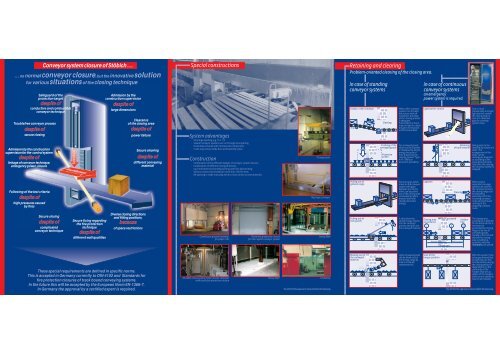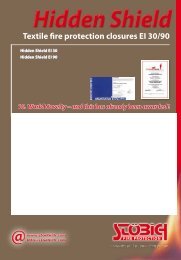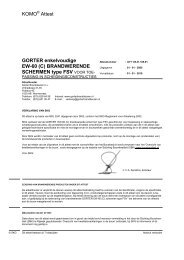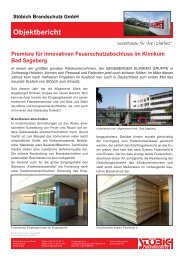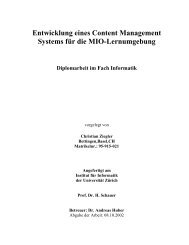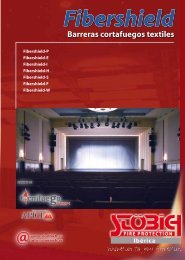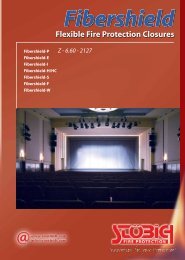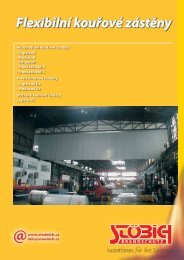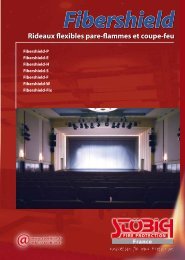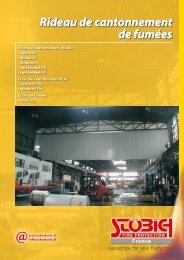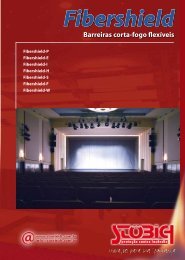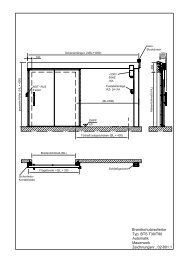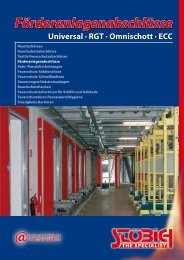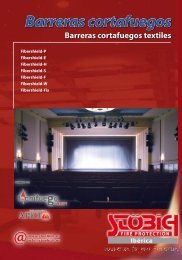Type S Addresses - Stöbich Brandschutz
Type S Addresses - Stöbich Brandschutz
Type S Addresses - Stöbich Brandschutz
Create successful ePaper yourself
Turn your PDF publications into a flip-book with our unique Google optimized e-Paper software.
Conveyor system closure of <strong>Stöbich</strong> . . .<br />
… no normal conveyor closure, but the innovative solution<br />
for various situations of the closing technique<br />
Safeguard of the<br />
protection target<br />
despite of<br />
conductive and combustible<br />
conveyor technique<br />
Troublefree conveyor process<br />
despite of<br />
secure closing<br />
Admission by the construction<br />
supervision for the control system<br />
despite of<br />
linkage of conveyor technique,<br />
emergency power, closure<br />
Following of the test criteria<br />
despite of<br />
high pressures caused<br />
by fires<br />
despite of<br />
Secure closing<br />
complicated<br />
conveyor technique<br />
Secure fixing regarding<br />
the fire protection<br />
technique<br />
despite of<br />
different wall qualities<br />
Admission by the<br />
construction supervision<br />
despite of<br />
large dimensions<br />
Clearance<br />
of the closing area<br />
because<br />
despite of<br />
power failure<br />
Diverse closing directions<br />
and fitting positions,<br />
of space restrictions<br />
These special requirements are defined in specific norms.<br />
This is accepted in Germany currently to DIN 4102 and Standards for<br />
fire protection closures of track bound conveying systems.<br />
In the future this will be accepted by the European Norm EN-1366-7.<br />
In Germany the approval by a certified expert is required.<br />
Secure clearing<br />
despite of<br />
different conveying<br />
material<br />
Special constructions<br />
System advantages<br />
· Very large opening, e.g. 15 x 1 m<br />
· Several conveyor systems can run through one opening<br />
· Fixed deep closures with intumescent components<br />
· Crane way closure (slide door and butterfly valve)<br />
Construction<br />
· Combination of the different designs of conveyor system closures<br />
· Combination of different closing directions,<br />
e.g. from below horizontally pushing and from above tilting<br />
· Various constructions based on more than 100 fire tests<br />
· Re-opening is made manually, electric motor driven or pneumatically<br />
Continuous ground conveyor<br />
for paper rolls<br />
Movable closure plane at the circular conveyor<br />
with textile fire protection closure<br />
Textile fire protection closure<br />
for interrupted conveyor system<br />
Storey lifter<br />
Tilt tray sorter<br />
Nap tape conveyor<br />
Storey lifter<br />
Craneway<br />
You will find the approval in www.stoebich.de/zulassung.<br />
Retaining and clearing<br />
Problem-oriented clearing of the closing area.<br />
In case of standing<br />
conveyor systems<br />
Gravity roller conveyor<br />
Stop M<br />
Pulling out of<br />
general cargo<br />
Pulling out of<br />
bulk goods<br />
Blowing out of<br />
the conveyed<br />
material<br />
Clearing<br />
Crushing of the<br />
conveyed goods<br />
Protective<br />
screen<br />
When roller conveyor<br />
systems run through<br />
the closure with an<br />
inclination, the delay<br />
of the closing process<br />
is adequate.<br />
Precondition is that it<br />
may not lead to a back<br />
draught of the goods<br />
to the closure level.<br />
For conveyed goods,<br />
which can be crushed<br />
or displaced by kinetic<br />
energy because of<br />
their properties, the<br />
clearing system “<strong>Type</strong><br />
A-Y1” offers an<br />
economic possibility.<br />
General cargo, which<br />
move on the conveyor<br />
system with gaps<br />
between one to the<br />
other, can be pulled<br />
out of the closing area<br />
via swivelling return<br />
motion lever with<br />
stored pneumatic<br />
energy.<br />
A rake, driven by<br />
stored energy, swivels<br />
into the conveyor<br />
process and pulls out<br />
the conveyed material.<br />
Light conveyed goods<br />
can be blown out of<br />
the closing range by<br />
means of stored<br />
compressed air.<br />
In case of continuous<br />
conveyor systems<br />
an emergency<br />
power system is required.<br />
Light barrier control<br />
Logistics<br />
Stop M M<br />
Closing area<br />
surveillance<br />
Scan of the<br />
hanger position<br />
Initiator occupied<br />
Clearing<br />
Initiator<br />
free<br />
I II III<br />
Passage safeguard Parking space<br />
Security area<br />
One or more<br />
transversally arranged<br />
light barriers control<br />
the closing level. In<br />
case of a detected<br />
gap the conveyor<br />
system stops.<br />
Retaining Bulk goods can be<br />
of bulk material retained by means of a<br />
slider . The<br />
arrangement of the<br />
slider can be<br />
rectangular, diagonal<br />
or according to the<br />
snow plow principle.<br />
Only after the clearing<br />
the conveyor system is<br />
stopped.<br />
When several<br />
separated conveyor<br />
systems are used for<br />
the conveyor process,<br />
the closing range can<br />
be cleared by<br />
switching-off of the<br />
incoming conveyor<br />
route and continued<br />
running of the<br />
outgoing conveyor<br />
route.<br />
The closing area<br />
surveillance is defined<br />
for the distance that is<br />
necessary to<br />
guarantee the closing<br />
range to be free of<br />
conveyed goods.<br />
Usually in front of and<br />
behind this closing<br />
area surveillance,<br />
proximity switches<br />
(initiators) are placed.<br />
With this system it has<br />
to be guaranteed that<br />
all openings are free<br />
simultaneously during<br />
the closing period. In<br />
dependence on the<br />
uniformity of the<br />
hanger distances as<br />
well as of the hangers<br />
itself, control elements<br />
have to be installed.<br />
You will find the approval in www.stoebich.de/zulassung.


